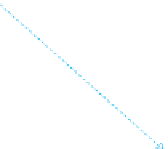Biomedical Engineering Reference
In-Depth Information
FIGURE 6.2
Collision between two hard-sphere molecules.
v
0
B
¼
2
m
v
A
v
B
ð
m
A
m
B
Þ
A
(6.5)
m
A
þ
m
B
From
Eqns (6.4) and (6.5)
, it can be shown that:
m
B
, v
0
A
¼
v
B
, v
0
B
¼
1.
When m
A
¼
v
A
, the pre- and postcollision velocities are exchanged
between molecules of equal mass.
m
B
, v
0
A
z
v
A
, v
0
B
z
2.
When m
A
>>
v
B
, the velocity of a light molecule is profoundly
affected by collision with a heavy molecule, while the velocity of the heavy molecule
remains essentially constant.
2v
A
The exchange of kinetic energy, and thus velocity, as illustrated will ensure the existence of
a distribution of velocities: energy is conserved in collisions where velocity is not
conserved.
By making some rather general postulates concerning the nature of this distribution, we
can derive its specific mathematical form. We shall suppose an isotropic medium at equilib-
rium such that the number of molecules in any region is the same and the velocities in any
direction are “equal,” which requires that the components of velocity along any system of
the coordinate directions are “equal” and independent of coordinate system. Also, we
suppose that the velocities along any three coordinate axes are independent of each other
and that the change of a velocity lying between certain limits is a function only of the
velocity and the limits considered. The details of the derivation are beyond the scope of





















































































































Search WWH ::

Custom Search